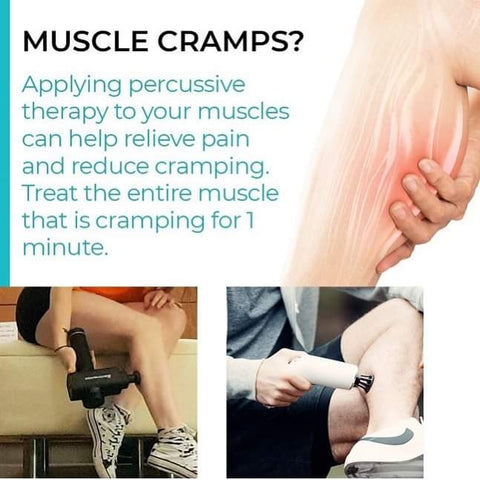Many athletes at one point or another has had experienced a varying degree of a muscle cramp. Muscle cramps and spasms are involuntary, uncontrollable, painful, and transient muscle contraction that occur suddenly and then disappear after a few seconds or several minutes and so, without consequences. Cramps can affect any muscle but most commonly strike the calves, hamstrings, and quadriceps.
EXERCISE-ASSOCIATED MUSCLE CRAMP
Exercise-Associated Muscle Cramp or EAMC occurs during or after any strenuous physical activity. Although numerous causes have been studied, the two widely accepted theories for EAMC are dehydration or electrolyte imbalances and altered neuromuscular control.
Electrolyte Depletion and Dehydration
The main point of this theory relies on the fact the our bodies require adequate fluids and electrolytes for muscle contraction. Physical activities deplete the body’s fluid and electrolytes through sweating, which stimulates nerve endings and reduces the spaces between muscle cells, resulting in cramping. Muscle cramps are more likely when you exercise in hot and humid environments where sweating and dehydration mostly occur. This theory, however, is inconsistent as studies do not show association between EAMC and electrolyte imbalances or fluid loss. Also, treatment of EAMC fails to support this theory as fluid replacement does not consistently and adequately treat muscle cramping.
Altered Neuromuscular Control
Stronger evidence exists that the cause of muscle cramps is more neuromuscular. The findings indicate that muscle fatigue can develop cramps. Repetitive or continuous muscle contractions and overloading result in muscle fatigue, which increases the excitatory afferent stimulation from the muscle spindles, while decreasing the inhibitory afferent stimulation from Golgi tendon organs (GTO).
- Muscle spindle are sensitive to changes in muscle length and the speed of lengthening, thus, to stretching, while GTO senses changes in muscle tension.
- The muscle spindle alerts the brain of danger of being overstretched and so muscle is activated to prevent it.
- When a muscle undergoes too much of tension, the GTO inhibits muscle activation to decrease muscle tension and prevent damage.
IMMEDIATE TREATMENT OF EAMC
Acute static stretching has proven to be effective immediate relief for EAMC as well as other types of muscle cramps, except heat cramps. The described mechanism is the stimulation of the GTO, which inhibits alpha motor neuron activity. Also, massaging the affected muscle stimulates blood flow and loosens the spasm.
- Gently stretch and massage the cramping muscle, holding the stretch for 15 to 30 seconds or until the muscle relaxes.
- Temporarily avoid doing any activity that triggered the cramping. Limiting or delaying the activity allows the muscles and the central nervous system to recover.
- Applying heat to the area for a few minutes while stretching may also help.
TIPS FOR PREVENTION OF EAMC
The following may reduce the tendency for muscle cramps:
Nutrition and Hydration
Despite the lack of evidence regarding the dehydration theory, maintaining hydration and adequate electrolyte levels is a good prevention strategy. Drinking a liter of water or sports drink before training or competition ensures that adequate fluid and electrolytes are available for your body to use. Also rehydrate throughout exercise to replenish loss fluids via sweat. The National Athletic Trainers’ Association (NATA) and the American College of Sports Medicine (ACSM) recommend a fluid intake that allows losing less than 2% of your body weight during activity. Always observe a balanced diet to maintain adequate hydration and electrolyte levels between exercises.
Neuromuscular Training
Conditioning that incorporates neuromuscular training may help delay muscle fatigue, and therefore EAMC. Plyometric exercises may cause neural adaptations in muscle spindle and GTO, enhancing neuromuscular control. Endurance training may also prevent EAMC by improving the muscle’s resistance to neuromuscular fatigue.
Flexibility Training
The importance of flexibility cannot be overstated. Poor flexibility predisposes the muscle spindle and GTO to malfunction. Maintaining flexibility of the muscle groups most prone to cramping prevents the muscles to contract involuntarily. Regular flexibility exercises for at least five to 10 minutes during warm-up and cool-down periods can help prevent cramps.
HOW RECOVAPRO HELPS WITH EXERCISE-ASSOCIATED MUSCLE CRAMPS
When your body is poorly conditioned because of training errors including inadequate warm-up and poor active recovery to cool down, you are more likely to experience muscle fatigue. You tend to overexert, which depletes your muscle’s oxygen supply, leading to build up of wastes such as lactate in the tissues and blood. Further, muscles that are inflexible tire more quickly, causing the opposing muscle groups to work harder. All of these scenarios lead to muscle fatigue and subsequent altered neuromuscular control, which is a causative factor for muscle cramps.
A regular program of stretching allows muscles to contract more vigorously during exercise. Keeping your muscles loose and flexible will prevent them from tightening up and cramping. Flexibility also improves neuromuscular coordination.

The RecovaBall may help in improving flexibility of muscles prone to cramping. It’s an effective self-myofascial tool designed to break up adhesions or loosen severely tight muscles to prevent muscle cramps.
The Recovapro massage gun also improves flexibility through enhanced circulation. Use it as a warm-up tool to keep muscles loose prior to training and a cool-down device to help speed up lactate clearance more effectively than traditional active recovery strategies.





















